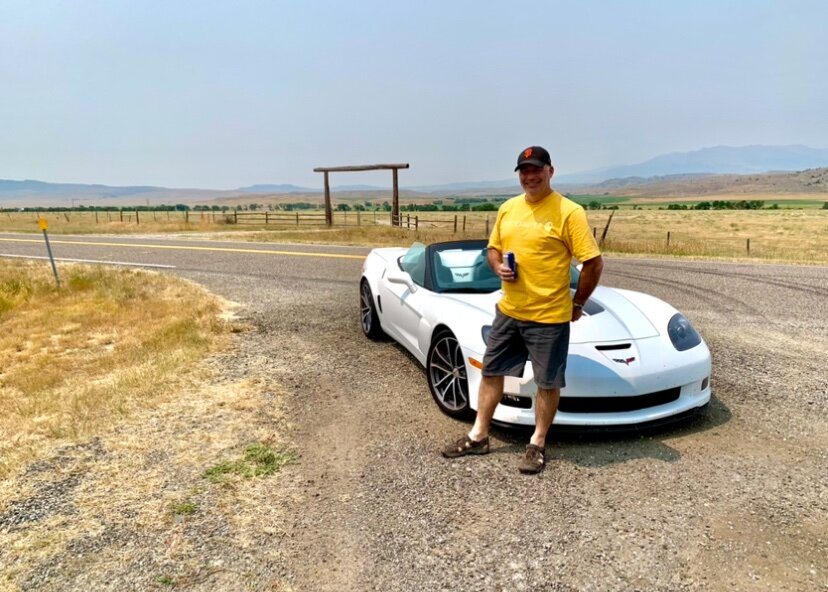-
Posts
3,462 -
Joined
-
Last visited
-
Days Won
193
Content Type
Links Directory
Profiles
Articles
Forums
Downloads
Store
Gallery
Blogs
Events
Everything posted by keithb7
-

1939 Chrysler Royal Transmission Leaking in front
keithb7 replied to Herding Goats's topic in P15-D24 Forum
I’m not smart enough to figure out what that paper gasket between the transmission and the flywheel housing, is sealing. Is it the area where the counter balance shaft protrudes through the transmission housing? I just put some aviation black sealant in the bore before I set the countershaft in place. I guess there may not have been such a product in 1939. -
I’m in Billings Montanan tonight. Somewhere near Cheyene tomorrow nite. Denver Colorado Tues nite. I’ll be at the Rockies/Red Sox game! Salt Lake City likely Wed nite this week. Then we head NW up and back home to BC Canada. Thus/Fri/Sat. Boise. Ontario Oregon. Moses Lake ish and North to the border. Any Mopar fans here along that trail? Cold beer will cause me to stop, and have a visit over some old Detroit iron. If interested in a meet up let me know. Nowhere Montana today:
-
@Los_Control that’s one heck of a great example to be smearing around the internet. Wow. A ton of sludge in there! I cannot imagine running an engine as long as it would take to accomplish that, and never take the valve covers off. Lol. “Engine developed a miss. It got worse so I parked it. Ran when parked”. Lol.
-
https://youtu.be/rI5-MPzZtwM?si=adwXe-f4zZUL2pU_
-
Remove oil filter. Cut it open. Press out oil from paper in a vise. Inspect for shiny material. That will confirm if tappet and cam lobe are failing. I published a video its on YT. Detailed instructions how to do this.
-

Crankcase Ventilator Tube dripping oil '37 Flathead 6
keithb7 replied to Kels's topic in P15-D24 Forum
My understanding is engine oil becomes a fine airborne mist inside the crankcase. The block vent down-tube is cut on a 45-ish degree angle. This creates a scavenging effect while the car is moving. Crankcase fumes are released and sucked into the atmosphere. The oil mist surely exits too. I would expect oil to be collecting on the draft tube walls. How much? I’m unsure. Is your engine oil level a bit high maybe? As mentioned, blow-by from new, un-seated piston rings could contribute to excessive crankcase pressure. Then increased exit of misty oil. What about adjacent piston ring end-gaps lined up together? That could do it too. -

Ammco Safe Arc Cam Grinding Brake Shoes purchase
keithb7 replied to desoto1939's topic in P15-D24 Forum
My experience with shoe fitment has been good. I put one new set of pads on the front for example. Adjust them very close to the drum. Major and minor settings. Go for a drive. Ride the brakes a bit longer a couple times. When you get home set the minor adjustments tight again. Go for another drive and work the brakes a few times again. Adjust brakes as needed. Probably just another minor is required. Then I was done. They self-arc’d nicely. My brakes performed quite good. For safety just don’t install all four brakes with new shoes and break them in all at once using this method. Do one axle. Get them arc’d and set. Then do the second axle. Back in the day when these cars were people’s main mode of daily transportation, an arcing machine made sense. Drop the car off at the garage. Get it done. Drive it away a couple hours later. Today most of us are casual drivers of these old cars. With plenty of time do the brakes. We’re often doing the brake work ourselves. Sending brake shoes away, along with drum measurements for arcing doesn’t make sense for me. A few extra cost-free easy steps, the brakes are arc’d and ready to go. That’s been my experience. -
I will admit the new Gates water pump that I installed holds the only metric hardware in my entire car.
-
The cooling fan and drive pulley thread into the shaft flange in the waterpump. In my experience that’s not worth taking apart. New Gates waterpumps appear decent and reliable. They are priced attractively. Probably not worth trying to rebuild. But that’s just me.
-
Forecast is 104F here next week. I like 20W40 oil in my de-sludge’d flathead engine. My version of an auxiliary electric fuel pump:
-
With non-functioning vacuum advance is the engine hard to start? I assume the spring on the advance is still functioning. So probably starts fine.
-
Is it possible that the in-line electric fuel pump that you installed, when not on, is creating an obstruction for the mechanical fuel pump? Letting fuel through but not quite enough that the engine needs? When you hit the switch on the electric pump it refills the lines, mechanical pump and bowl quickly? Try going for a drive and turning on the electric pump switch about every 2-3 miniutes for a duration of about 3-5 seconds. Do this for a few trips. Does the problem appear or not?
-
My vote is no on that timing chain set. Order one from Vintage Power Wagons or somewhere else. The product quality and customer service from that E-bay seller is questionable at best.
-
I don’t think I’m switching anything. Did I elude that I was? Sorry. Can you explain a bit more from your initial post. “It just drops to idle while driving”. I’m trying to imagine this happening. Driving down the road the transmission engaged, the rear wheels push the engine’s flywheel around. The engine can’t really drop to an idle. Unless you mean the engine power dies. No response from the foot throttle? You coast to the side of the road and the engine just idles and won’t speed up on pushing the gas pedal? You hit the switch on your electric fuel pump, then things return to normal? It accelerates fine?
-
Front crank seal. Speedi sleeve may be a good idea. Is rad out? Drop it off at rad shop for a cleaning and test. New timing cover gasket. Be sure you get the upgraded timing chain with extra row of center strut links.
-
If you are working with an old car with unknown age of fuel tank, fuel lines, there’s plenty of things that can happen. Sediment. Scale. Rust. Water in tank. Leaking fittings. Crusty fuel hoses. Chunks in the carb inlet valve. SedIment in the bowl. Partially plugged jets. Failing rubber in the fuel pump. Accelerator pump. On and on. There’s been a few posts lately on the topic. Sorry if I mix up the details. In general, understanding the basics, what something is supposed to do, how it interacts with something else, how it contributes to a properly running engine, will help you tremendously in diagnosing the problem. Your coil is oil filled to keep it cool. How cool? I’m unsure. I’ve never ran a laser thermometer on it after a drive on a hot day. I’ll do maybe next time I am out in my old Mopar. I’m interested is seeing how hot it gets. Are you running the stock 6V system with positive ground, and 6V battery?
-
I’m thinking there may be more than one thing going on here. What sort of ambient temps are you seeing?
-
Options I can think of include finding spare used carbs and swapping out worn parts. You may also be able to meet up with a friend who can machine bushings and enlarge bores in the carb to install them. This would tighten-up gaps and stop air leaks. You could also consider buying a new carb. I’m not informed in this area. Sounds like you can buy carbs that will fit and work. I have. No idea about quality and support with them. Could be done if you know needed air-flow and jetting.
-
To control idle speed you need to control air intake as well. If your carb has air leaks where it should be sealed, it’ll idle high. The only air entering into your carb needs to enter down through the top air horn only. Other points of air entry means you don’t have control of the air. Your engine is running-off on its own. This is also why your air/fuel mixture screw has no effect. It only works when you have proper control of the of air entering the carb. You don’t have that.
-
If you are tinkering on the car, trouble shooting, and you leave the ignition key on, and the points happen to be closed, the coil gets hot.
-
Fuel delivery in the needed volume is aa good guess. The mechanical advance on the distributor is another good place to look for possible issues. How about a failing condenser? Can't keep up a such short dwell times at high rpm? Ripping down the highway at a steady RPM the engine needs a reliable, steady supply of fuel at a fairly decent volume. If the fuel system cannot keep up that the engine is calling for, it sputters out. You can look at anything related to a steady strong supply of fuel. Fuel delivery lines. Air leaks? A fuel line connection loose? Fuel pump PSI and GPM. Vapor lock? Carb bowl inlet valve? Float level.Plugged partial plugged main jet? Carb air leaks? Fuel filter partially plugged? Good free flowing, fully controlled air intake? Fuel is just one area to look at. Then there's the ignition system. We can come up with a good list of items to check. Dwell. Timing. Advance. Coil. Wires. Cap and rotor. Condition of wires from key switch to coil and beyond. Points & condenser. Then there's mechanical things like, proper valve timing. Valve set. Valve condition and seal-ability. Manifold leaks. Fuel tank venting. Timing chain and gears wear. All this and more should be in good condition for proper engine running and performance. That's a lot, but from here it's hard to pin point one thing to focus on. All these mentioned systems must work together.
-

Positive ground system?? Don’t want the pain it comes with…
keithb7 replied to BayArea48Deluxe's topic in P15-D24 Forum
Slammed low, aggressive pneumatics? A guess. Something like that? -
@Hook47 if you just want to check wheel bearings jack up the rear end. Wiggle the rear wheels. Spin the rear wheels. Any thing feel a little granular? Push and pull drum and axle in and out towards center diff. Should be a little play. Not much. If I recall .008-.012” or so? Don’t quote me on that. Get a mechanic stethoscope. Place the tip on axle housing where the wheel bearing sits. Spin the wheel. Listen for excessive noise. What would be excessive? Have a listen to your other bearings and compare. Remove the grease plug. Is there any grease in there? Get a horse syringe. Fill it with grease. Pump grease into hole. Fill it up. Spin bearing. Fill it up again. DO NOT USE A GREASE GUN.
-
The rear wheel bearings and inner axle seals is a fairly time consuming job. You’ll need a dial indicator. A brake drum puller, & ideally a slide hammer for the inner seal. Someome with a press to remove bearings off the axle, and press new ones on. Plus the concentric brake shoe tool. Possibly more shims and new outer grease axle seals.




